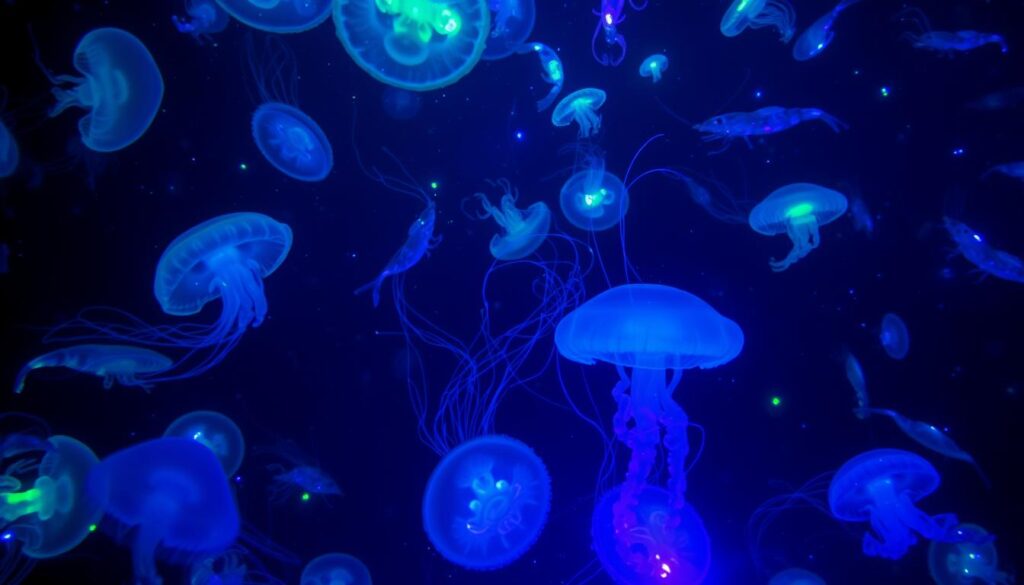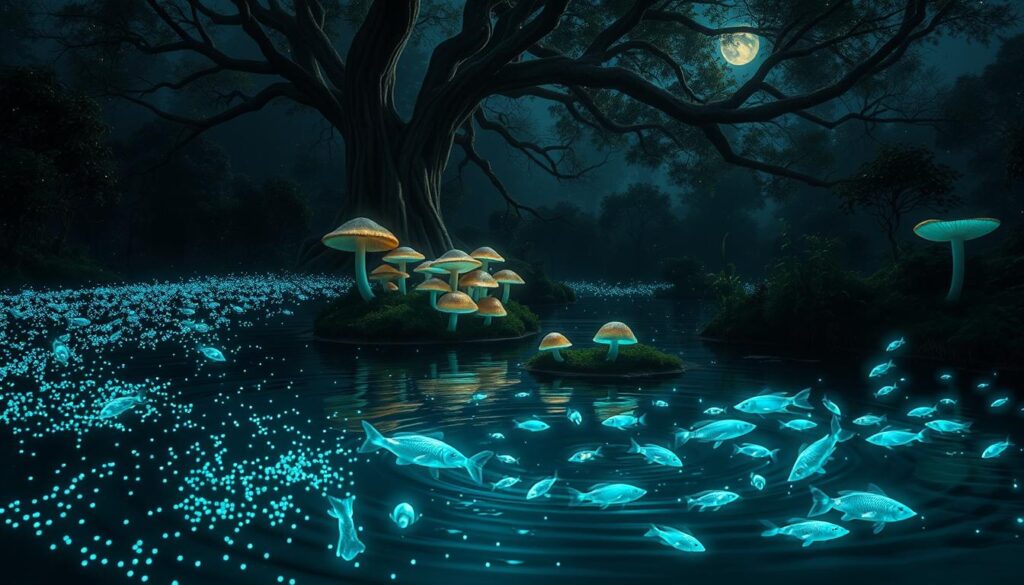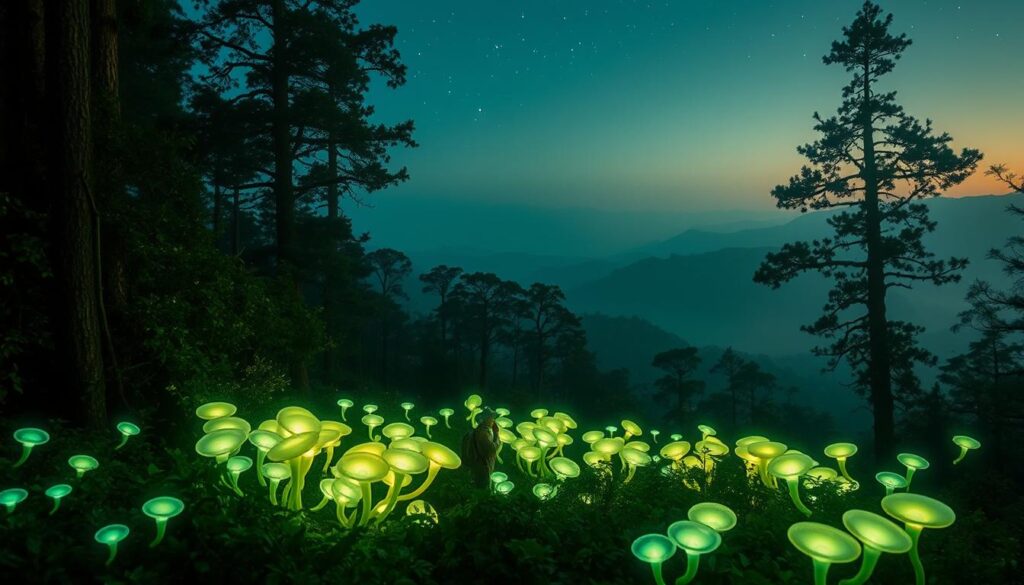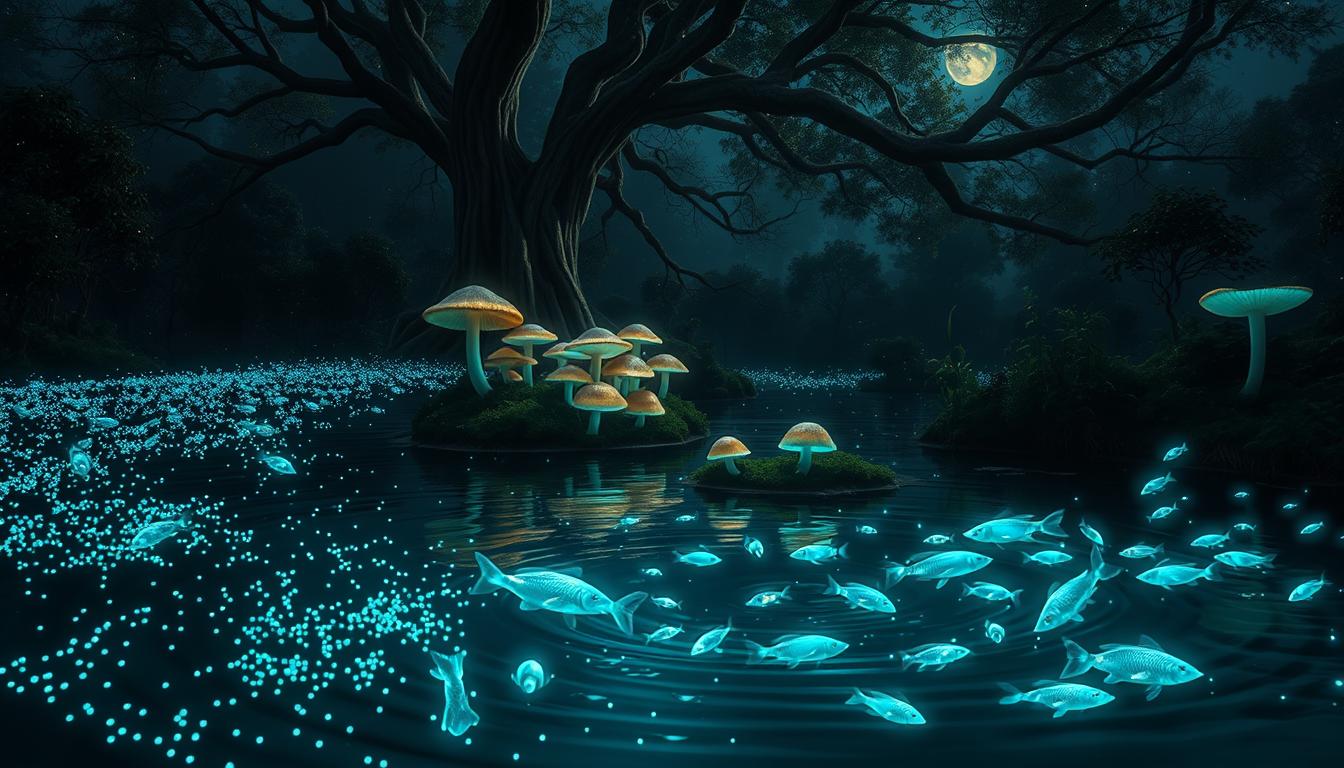In the natural world, there are creatures that can light up on their own. This is called bioluminescence. These glowing animals, found in the deep sea, amaze and inspire us with their ability to shine in the dark. Bioluminescence is a natural process that lets some living things glow in the dark.

Bioluminescent animals can be found everywhere, from the ocean’s depths to forests and grasslands. Scientists are deeply interested in studying these creatures. They want to learn the secrets behind their glowing abilities. Deep-sea creatures, like some fish and jellyfish, light up the dark ocean to survive and thrive.
Key Takeaways
- Bioluminescence is the ability of certain living organisms to produce their own light.
- Glowing animals, including deep-sea creatures, can be found in various forms and species.
- Bioluminescence is a natural process that occurs in certain living organisms.
- The study of bioluminescence and glowing animals is a fascinating field of research.
- Deep-sea creatures have evolved to produce their own light in order to survive and thrive in the dark depths of the ocean.
- Bioluminescence plays an important role in the survival and communication of certain animal species.
The Natural Magic of Bioluminescence
Bioluminescent animals can light up on their own. This is due to complex chemical reactions in their bodies. For centuries, humans have been amazed by this ability. Scientists study it to learn how these creatures glow.
The chemistry behind bioluminescence is complex. It involves enzymes, pigments, and oxygen. These work together to create light. This light is then released by the animal. It’s not just interesting science-wise but also has practical uses.
- Chemical reactions: These are the base of bioluminescence, creating the light.
- Enzymes: These biological molecules help the chemical reactions happen in bioluminescent animals.
- Pigments: These substances absorb and emit light, causing the glow of bioluminescent creatures.
Studying bioluminescent animals and their chemical reactions can teach us a lot. It could also lead to new discoveries and uses in the future.
Animals That Glow in the Dark: A Fascinating World of Light
The world of bioluminescent creatures is full of variety. From tiny plankton to huge squid, these glowing animals light up their surroundings. This light is key to their survival and success. It’s found everywhere, from the deep sea to the forest floor.
Some of the most interesting glowing animals are fireflies, glowworms, and certain fish and squid. They use light to talk, attract food, and protect themselves. For instance, fireflies glow to find mates, and glowworms light up to catch insects.
Here are some examples of bioluminescent creatures and their unique traits:
- Fireflies: use their glow to attract mates
- Glowworms: use their light to lure in prey
- Squid: use their bioluminescence to communicate and defend against predators
Theseglowing animals are crucial to thewildlifeecosystem. Their light is essential for their survival and success.
Deep Sea Luminescent Creatures
The deep sea is filled with bioluminescent creatures. These include deep-sea fish and jellyfish that light up the dark. They have evolved to make their own light, helping them survive in the deep.
Anglerfish and firefly squid are among the most interesting. Anglerfish use a head lure to catch prey. Firefly squid have special cells that light up their body.
Glowing jellyfish also live in the deep. They use their light to attract prey and talk to other jellyfish.
Here are some key traits of these creatures:
- Ability to produce their own light through bioluminescence
- Specialized light-producing cells or organs
- Use of bioluminescence for survival, such as attracting prey or communicating with other creatures
These amazing creatures are still a mystery to us. Scientists keep studying them to understand more. By exploring these creatures, we learn about the diversity of life on Earth.
Terrestrial Light Shows: Glowing Land Animals
Glowing animals like fireflies and glowworms are amazing examples of bioluminescent creatures. They can light up their surroundings. This light helps them attract prey, talk to others, and even defend against predators.
Some insects, like beetles and flies, can also light up. They use this light to find mates or scare off rivals. Bioluminescence is a complex process that creates light through chemical reactions.
Even mammals, birds, and reptiles can glow in the dark. For instance, some frogs and toads glow to catch prey or talk to others.
Here are some examples of glowing land animals:
- Fireflies: use their bioluminescence to attract mates and warn off predators
- Glowworms: use their light to attract prey and communicate with other glowworms
- Certain species of insects: use their bioluminescence to attract mates or warn off competitors
These are just a few examples of the many fascinating bioluminescent creatures in terrestrial wildlife.
The Famous Firefly: Nature’s Original Night Light
Fireflies, also known as bioluminescent insects, have long fascinated people. They can light up the night, unlike any other insect. This ability is not just beautiful but also key to their mating rituals.
Fireflies use light to talk to each other, especially when looking for a mate. Each species has its own light show. This way, they can find the right partner and keep their species alive.
How Fireflies Produce Their Glow
Fireflies light up through a special chemical reaction in their bodies. This reaction involves many molecular steps. It ends with the firefly shining its light.
Different Firefly Species Worldwide
There are over 2,000 types of fireflies, each unique. Some live in certain areas, while others are found all over.
Mating Rituals and Light Patterns
Fireflies’ mating rituals are complex. They use light signals to attract mates and show their species. These signals are crucial for finding the right partner.
Survival Advantages of Bioluminescence
Bioluminescence helps animals survive in many ways. It can defend against predators, attract prey, and help animals talk to each other. This special ability has helped some species live better in their homes. It’s mainly useful for defense and attracting food.
Some animals flash light to warn predators they’re not good to eat. Squid, for example, confuse predators with glowing clouds. Fireflies light up to find friends or scare off rivals. This way of talking is cool because it doesn’t make heat.

Bioluminescence is also key for hunting. Some fish use glowing lures to catch dinner. Others glow to sneak up on food. These tricks help them survive and thrive.
Some main perks of bioluminescence are:
- Defense against predators
- Attracting prey
- Communication with other animals
These benefits show how important bioluminescence is for animals. Scientists and animal lovers will keep studying and loving it.
Human Applications of Natural Bioluminescence
Bioluminescence is used in many ways, from medicine to art. Scientists are working to use it for new lighting, medical tools, and creative projects. For example, they’re studying bioluminescent creatures to make better, greener lights.
Using bioluminescence could save energy and make things safer. In medicine, it’s helping create new ways to diagnose and treat diseases. It’s also leading to cool tech like glow-in-the-dark stuff and light shows.
- Development of new lighting technologies
- Biomedical applications, such as diagnostic tools and treatments
- Artistic expressions, such as glow-in-the-dark art and bioluminescent displays
Bioluminescence is changing many areas and making our lives better. As scientists learn more, we’ll see even more cool uses of this natural wonder.
Conservation and Environmental Impact
It’s vital to protect bioluminescent species for our planet’s health. Human actions like pollution, habitat loss, and climate change harm them. Bioluminescent species live in many places, from deep sea to land. They help keep their ecosystems balanced.

Threats to Bioluminescent Species
Big threats to bioluminescent species include:
- Habitat loss from deforestation and coastal projects
- Pollution from chemicals and plastics that can harm or kill them
- Climate change, which can change where and how many bioluminescent species there are
Protection Efforts Worldwide
People around the world are working to save bioluminescent species and their homes. They create protected areas like marine reserves and national parks. They also start programs to cut down pollution and habitat loss.
By supporting conservation and lessening our environmental impact, we can keep bioluminescent species beautiful and diverse for the future.
Nature never ceases to amaze us, from glowing creatures to fish that can move on land
Conclusion: Preserving Nature’s Living Lights
The world of bioluminescent animals is truly amazing. These creatures can light up on their own, a skill they’ve had for millions of years. It helps them survive in many different environments.
But, many of these animals are in danger. They face threats like losing their homes, pollution, and climate change. We must act to save them. This is important for their own sake and for the science they can teach us.
By protecting their homes and spreading the word about their importance, we can help. This way, future generations can still be amazed by these natural wonders.
Let’s cherish the beauty of bioluminescence and work to protect these special creatures. Together, we can keep their light shining bright, inspiring wonder and awe for many years.
FAQ
What is bioluminescence?
Bioluminescence is when living things, like animals and plants, make light. It happens through complex chemical reactions. These reactions release light energy.
What causes animals to glow in the dark?
Animals glow because of a chemical reaction. This reaction involves luciferase and luciferin. When these mix with oxygen, they create light.
What are some examples of bioluminescent animals?
Fireflies, glowworms, and anglerfish are well-known for glowing. Firefly squid and some jellyfish and plankton also glow.
How do bioluminescent animals use their glow?
Animals use their glow for survival. It helps them attract prey, scare off predators, and talk to others. This glow is a key survival tool.
What are the human applications of bioluminescence?
Humans use bioluminescence in many ways. It helps create new lights, aids in medicine, and inspires art. Bioluminescent art is a big part of this.
What are the threats to bioluminescent species?
Bioluminescent animals face many dangers. These include losing their homes, pollution, and climate change. We must work to save these special creatures.
